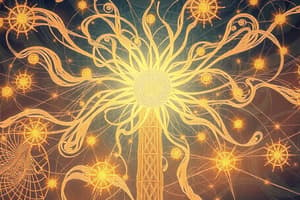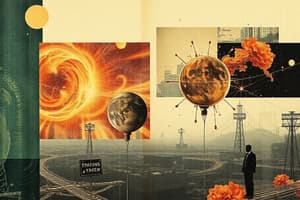Podcast
Questions and Answers
Which of the following is NOT a type of energy store?
Which of the following is NOT a type of energy store?
- Sound Energy (correct)
- Chemical Energy
- Kinetic Energy
- Gravitational Potential Energy
Energy can be created and destroyed in a closed system.
Energy can be created and destroyed in a closed system.
False (B)
What is the formula for calculating power in terms of energy transferred?
What is the formula for calculating power in terms of energy transferred?
Power = Energy Transferred / Time
The energy stored in an object's height above the ground is known as __________ energy.
The energy stored in an object's height above the ground is known as __________ energy.
Match the type of energy to its description:
Match the type of energy to its description:
What does efficiency measure?
What does efficiency measure?
Power is calculated as the amount of work done divided by the time taken.
Power is calculated as the amount of work done divided by the time taken.
A ball thrown into the air changes its __________ energy to gravitational potential energy as it rises.
A ball thrown into the air changes its __________ energy to gravitational potential energy as it rises.
Which of the following energy transfers occurs due to temperature differences?
Which of the following energy transfers occurs due to temperature differences?
Power is measured in joules.
Power is measured in joules.
What is the formula for calculating efficiency?
What is the formula for calculating efficiency?
A lightbulb that transfers 20 J of energy as light from 100 J of energy supplied has an efficiency of _____.
A lightbulb that transfers 20 J of energy as light from 100 J of energy supplied has an efficiency of _____.
Which of the following energy sources is renewable?
Which of the following energy sources is renewable?
Explain what happens to a ball thrown into the air in terms of energy transfer.
Explain what happens to a ball thrown into the air in terms of energy transfer.
Energy can only be created or destroyed in a closed system.
Energy can only be created or destroyed in a closed system.
The wave speed can be calculated using the formula _____.
The wave speed can be calculated using the formula _____.
Match the following types of energy stores with their descriptions:
Match the following types of energy stores with their descriptions:
What is the power output of a motor that transfers 2400 J of energy in 3 seconds?
What is the power output of a motor that transfers 2400 J of energy in 3 seconds?
Which of the following is a disadvantage of fossil fuels?
Which of the following is a disadvantage of fossil fuels?
Renewable resources produce greenhouse gases during operation.
Renewable resources produce greenhouse gases during operation.
What is the definition of a wave?
What is the definition of a wave?
The formula for wave speed is Wave Speed = Frequency × __________.
The formula for wave speed is Wave Speed = Frequency × __________.
Which electromagnetic wave is used in cooking?
Which electromagnetic wave is used in cooking?
Higher frequency electromagnetic waves carry less energy than lower frequency waves.
Higher frequency electromagnetic waves carry less energy than lower frequency waves.
What does red-shift indicate about galaxies?
What does red-shift indicate about galaxies?
The unit of electric charge is the __________.
The unit of electric charge is the __________.
Match the following components with their characteristics in series and parallel circuits:
Match the following components with their characteristics in series and parallel circuits:
What happens to the peak wavelength of black body radiation as the temperature increases?
What happens to the peak wavelength of black body radiation as the temperature increases?
Nuclear power generates greenhouse gas emissions.
Nuclear power generates greenhouse gas emissions.
What type of wave is sound?
What type of wave is sound?
The formula for calculating resistance using Ohm's Law is V = I × __________.
The formula for calculating resistance using Ohm's Law is V = I × __________.
Which of the following is NOT a renewable resource?
Which of the following is NOT a renewable resource?
Flashcards
Kinetic Energy
Kinetic Energy
Energy due to an object's motion.
Gravitational Potential Energy
Gravitational Potential Energy
Energy stored in an object due to its height above the ground.
Elastic Potential Energy
Elastic Potential Energy
Energy stored in a stretched or compressed object like a spring.
Thermal Energy
Thermal Energy
Signup and view all the flashcards
Chemical Energy
Chemical Energy
Signup and view all the flashcards
Power
Power
Signup and view all the flashcards
Conservation of Energy
Conservation of Energy
Signup and view all the flashcards
Efficiency
Efficiency
Signup and view all the flashcards
Useful Energy
Useful Energy
Signup and view all the flashcards
Wasted Energy
Wasted Energy
Signup and view all the flashcards
Amplitude
Amplitude
Signup and view all the flashcards
Wavelength
Wavelength
Signup and view all the flashcards
Frequency
Frequency
Signup and view all the flashcards
Wave Speed
Wave Speed
Signup and view all the flashcards
Waves
Waves
Signup and view all the flashcards
Magnetic Energy
Magnetic Energy
Signup and view all the flashcards
Electrostatic Energy
Electrostatic Energy
Signup and view all the flashcards
Nuclear Energy
Nuclear Energy
Signup and view all the flashcards
What is a System?
What is a System?
Signup and view all the flashcards
Fossil Fuels
Fossil Fuels
Signup and view all the flashcards
Advantages and Disadvantages of Fossil Fuels
Advantages and Disadvantages of Fossil Fuels
Signup and view all the flashcards
Advantages and Disadvantages of Nuclear Power
Advantages and Disadvantages of Nuclear Power
Signup and view all the flashcards
Advantages and Disadvantages of Renewable Resources
Advantages and Disadvantages of Renewable Resources
Signup and view all the flashcards
What are Waves?
What are Waves?
Signup and view all the flashcards
Amplitude of Waves
Amplitude of Waves
Signup and view all the flashcards
Study Notes
Energy (4.1)
- Energy Stores: Energy exists in various forms.
- Kinetic Energy: Energy of motion.
- Gravitational Potential Energy: Energy due to height and gravity.
- Elastic Potential Energy: Energy stored in stretched/compressed objects.
- Thermal Energy: Energy related to temperature and particle motion.
- Chemical Energy: Energy stored in chemical bonds.
- Magnetic Energy: Energy stored in magnetic fields.
- Electrostatic Energy: Energy stored in electric fields.
- Nuclear Energy: Energy stored in the nucleus of atoms.
- Systems: A system is an object or group of objects considered for analysis. Energy can be transferred:
- Into or out of the system.
- Between objects within the system.
- Between energy stores.
- Energy Transfers: Energy can be transferred mechanically, electrically, by heating, or by radiation.
- Power: Defines the rate at which energy is transferred or work is done.
- Formula: Power (W) = Energy Transferred (J) / Time (s) or Work Done (J) / Time (s).
- Unit: 1 Watt (W) = 1 Joule (J) per second. Higher power = faster energy transfer.
- Conservation of Energy: Energy cannot be created or destroyed, only transferred, stored, or dissipated.
- Dissipation of Energy: Useful energy is transferred. Wasted energy is lost as thermal energy to surroundings.
- Efficiency: Efficiency (percentage) = Useful Energy Transferred / Total Energy Supplied * 100.
- Reducing Energy Dissipation: Methods include insulation, lubrication, and streamlined designs.
National and Global Energy Resources
- Fossil Fuels (Coal, Oil, Natural Gas):
- Reliable, high energy output.
- Non-renewable, produces greenhouse gases.
- Nuclear Power:
- High energy output, no greenhouse gas emissions during operation.
- Non-renewable, produces radioactive waste.
- Renewable Resources: Sustainable, no greenhouse gases during operation; can be weather-dependent, high initial costs.
- Examples: Solar, wind, hydroelectric, geothermal, tidal, biomass.
Waves (4.6)
- Waves: Transfer energy and information without transferring matter.
- Types of Waves:
- Transverse Waves: Vibrations perpendicular to wave travel (e.g., light, water waves).
- Longitudinal Waves: Vibrations parallel to wave travel (e.g., sound waves).
- Wave Properties:
- Amplitude: Maximum displacement from rest.
- Wavelength (λ): Distance between corresponding points on adjacent waves.
- Frequency (f): Number of waves per second (Hertz).
- Period (T): Time for one complete wave (T = 1/f).
- Wave Speed (v): v = fλ.
- Electromagnetic Spectrum: Waves arranged by frequency (lowest to highest): Radio waves, Microwaves, Infrared, Visible light, Ultraviolet, X-rays, Gamma rays.
- All EM waves travel at 3 x 108 m/s in a vacuum. Higher frequency = more energy.
- Uses and Dangers: Detailed information for each type of radiation (e.g., radio waves for communication, microwaves for cooking, ultraviolet for sterilization, potential dangers of X-rays and gamma rays).
Electricity (4.2)
- Current (I): Flow of electric charge (measured in amperes, A). I = Q/t (where Q = charge, t = time).
- Potential Difference (Voltage, V): Energy transferred per unit charge (measured in volts, V). V = W/Q (where W = work done).
- Resistance (R): Opposition to current (measured in ohms, Ω). V = IR (Ohm's Law).
- Series Circuits: Same current through all components, total resistance is the sum of individual resistances, potential difference is shared.
- Parallel Circuits: Current splits between branches, potential difference is the same across each branch, total resistance is less than the smallest resistance.
Space Physics (4.8)
- Solar System: Consists of the Sun, planets, moons, dwarf planets, asteroids, and comets.
- Red-Shift: Increase in wavelength of light from distant galaxies, appearing redder. Evidence of galaxies moving away, universe expanding, and supports the Big Bang theory.
Studying That Suits You
Use AI to generate personalized quizzes and flashcards to suit your learning preferences.




